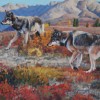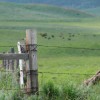Wolf reintroduction to Yellowstone National Park in 1995 triggered an endlessly fascinating stream of ecosystem responses. More than a decade and a half later, ecologists are still trying to determine 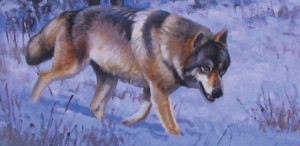 what restoration of a top predator means for the other species throughout the system.
what restoration of a top predator means for the other species throughout the system.
Ecologist Matt Kauffman was working as a postdoc in conservation biology at the University of Montana in Missoula in 2003 when he first heard about studies showing that wolves were scaring elk away from certain areas in Yellowstone so that vegetation like willows and aspen could recover. The idea that wolves could benefit vegetation not just by killing elk, but also by changing their behavior, intrigued him. Wolves, a top predator, influence relationships between species in an ecosystem through lethal effects, by reducing the number of browsers. But the idea that wolves could also affect vegetation simply by scaring the elk—a nonlethal effect—was new and exciting for terrestrial ecologists.
This was also an exciting idea for conservationists advocating for wolf recovery. Amidst the controversial recovery of a predator that kills livestock and big game—especially the hunters’ coveted elk—science now pointed to ways wolves benefited Yellowstone’s ecology and helped aspen recover without spilling any blood.
The process of a predator changing the way its prey interacts within its level in the ecosystem is termed a “behaviorally mediated trophic cascade.” Ecologists have studied how this works among insects and aquatic species since the early 80s. Through a BMTC, predators restructure an ecosystem’s vegetation composition by changing the ways herbivores forage. Ecologists were interested to test whether some of the principles found in small-scale manipulable systems would hold true in larger ecosystems.
The wolf reintroduction to Yellowstone in 1995 offered an unprecedented experimental opportunity. “The embodiment of this ecological idea of the nonlethal effect of predators (was) being played out on the biggest stage in the world,” said Kauffman.
The first paper suggesting that a BMTC may be unfolding in Yellowstone came out in 2000, and the idea quickly gained momentum among both ecologists and wolf recovery advocates. Popular media helped broadcast the story. The New York Times described the “ecology of fear” in 2005 and the March 2010 issue of National Geographic magazine included a foldout illustration of Yellowstone before and after wolf reintroduction emphasizing the recovery of streamside willows and upland aspen groves in areas where elk were no longer willing to forage.
But when Kauffman went to Yellowstone to prepare to design his own study of the BMTC, he didn’t see what he expected. He was surprised that even ecologists, who tend to require solid proof of stories as powerful as this one, had let the Yellowstone BMTC idea stand, because from his observations it wasn’t happening.
“In some ways the BMTC—that you could have these positive benefits on the plant communities that elk browse without having the wolves reduce the number of elk that are available for hunters—is too good to be true,” said Kauffman.
The BMTC
The idea behind the BMTC, first explored by aquatic ecologists in the 1980s, is that predators influence the ways their prey forage by scaring them into changing their behavior. Oswald Schmitz at the Yale University School of Forestry conducted some of the most renowned experiments to test this idea.
Schmitz studied spiders hunting grasshoppers inside screen cages in a field. He compared the ways grasshoppers foraged inside enclosures with and without predatory spiders present. When there were no spiders around, grasshoppers foraged almost exclusively on grass, but when a spider was introduced to the system, grasshoppers switched to feeding on forbs. The forbs offered refuge from the spiders, which tended to lurk in the grass.
Then Schmitz created an experiment where he applied a tiny drop of glue to the mouthparts of predatory spiders to create “risk spiders”—spiders that can scare grasshoppers, but can’t actually kill them. (He did tests to ensure the risk spiders behaved similarly to predatory spiders, and that they would survive for the duration of the experiments without perishing from the glue.) The grasshoppers had the same effects on vegetation whether they were in the presence of predatory spiders or risk spiders. That provided evidence, according to Schmitz, that spiders were influencing not just the number of grasshoppers, but also their behavior.
Ecologists usually think of terrestrial ecosystems as structured from the bottom up; that is, nutrient levels and soil determine vegetation, which determines how many and what kinds of creatures live there. But Schmitz’s work showed that simply adding a predator to a system significantly altered plants and even nutrient levels from the top down.
“(E)ach predation event only influences a single herbivore prey per unit time,” Schmitz wrote in 1997, “whereas the risk introduced by the mere presence of a predator could have more widespread effects, in that same time period, by causing many prey individuals to alter their foraging behavior.” This changed the way ecologists thought about the role of predators in terrestrial systems.
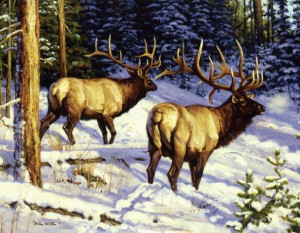 Kauffman called Schmitz’s research, “a particularly elegant demonstration of a BMTC,” adding that several other researchers have studied it in invertebrate and aquatic systems. Ecologists, he said, often study small manipulable systems—like enclosures in a field where spiders and grasshoppers interact—and then try to figure out if there are ways to scale up their findings to larger systems.
Kauffman called Schmitz’s research, “a particularly elegant demonstration of a BMTC,” adding that several other researchers have studied it in invertebrate and aquatic systems. Ecologists, he said, often study small manipulable systems—like enclosures in a field where spiders and grasshoppers interact—and then try to figure out if there are ways to scale up their findings to larger systems.
“It’s not that we are trying to stretch a grasshopper to make it look the size of a moose,” Schmitz said. “It’s the principles that you scale.” For example, ecologists may look for scale in principles about how herbivore behavior or physiology evolves in response to pressures from food availability and predation.
After wolf reintroduction in Yellowstone, William Ripple, an ecologist from Oregon State University, and his colleague Eric Larsen, began to examine Schmitz’s BMTC theories in Yellowstone. In 2000 they published an analysis of the history of aspen recruitment in Yellowstone National Park as it related to wolves. They wrote, “Wolves may positively influence aspen overstory recruitment through a trophic cascades effect by reducing elk populations, modifying elk movement, and changing elk browsing patterns on aspen.”
In 2001 Ripple and three more colleagues wrote with even more conviction about ways wolves were changing elk behavior and influencing vegetation recruitment: “(I)t appears that elk foraging behaviors may have been altered by the increased risk of predation due to the reintroduction of the wolf. In the riparian/wet meadow habitat type, mean aspen sucker heights were significantly higher in the high wolf-use areas than in the low wolf-use areas.”
Risk in Yellowstone
Kauffman was intrigued, and he developed a study to further investigate the wolf-elk-aspen BMTC. His study area was the Northern Range of Yellowstone, nearly 600 square miles of grasslands, shrubs and conifer forests that make up the winter range of the Northern Yellowstone elk herd. The range straddles the Lamar Valley where park visitors gather to view wolves. In the winter, the highway is lined with neon puffies as wolf enthusiasts peer through spotting scopes and binoculars.
When Kauffman visited the Northern Range for the first time, he expected to see stands of thriving aspen suckers throughout the Lamar Valley where wolves are known to hunt. Instead, “I was amazed that everywhere we looked, aspen had been heavily browsed,” he said. “So immediately I was thinking there must be something more to this story.”
As Kauffman considered the BMTC studies and their results, he realized one aspect of the wolf BMTC that needed elucidation was a better description of where on the landscape elk perceived risk of attack from wolves. He found there was little consensus about how to best characterize the “landscape of fear.”
Early studies of the BMTC in Yellowstone mapped wolf territories and described the core of those places as dangerous and the periphery as safer. But Kauffman had a different idea. He worked with Doug Smith, the wolf project leader in Yellowstone, who had collected ten years of data about wolf kills. Kauffman used 774 locations where wolves had killed elk—an especially robust data set—to create a “risk map” of the northern range. The risk map incorporates information about distribution of wolf packs and relative elk density as well as several landscape features including slope, snow depth, distance to streams and roads and whether the habitat is open grassland or forest. It shows, for example, that the center of the Lamar Valley is highly risky to elk, while the higher, forested ground away from rivers has a lower level of risk for elk.
With a data-driven risk map in hand (the first of its kind for Yellowstone wolves), Kauffman analyzed how well aspen were recovering in the risky areas compared to the less risky areas. He categorized aspen in 16 stands across the range as suckers, juveniles and adults. Suckers are less than 2 meters tall and are susceptible to browsing by elk. Juvenile trees are more than 2 meters tall, but have a diameter of less than 6 centimeters at about 5 feet above the ground. They have escaped being browsed by elk and are on their way to becoming adults.
If the BMTC was happening, stands in risky areas should have had more juvenile trees than stands in safe areas. But according to the published study, “No individuals in the juvenile class were found in natural stands.” The lack of juvenile aspen indicated none of the younger suckers escaped the intense browsing by elk, despite the influence of wolves.
 This surprised Kauffman. No one wanted to throw cold water on the BMTC idea in Yellowstone, but as an ecologist, Kauffman also wanted to get the science right. “And at the end of the day, it’s the role of science to characterize how wolves and other large predators interact in these systems. And if we don’t get it right that will have negative consequences down the road,” he said.
This surprised Kauffman. No one wanted to throw cold water on the BMTC idea in Yellowstone, but as an ecologist, Kauffman also wanted to get the science right. “And at the end of the day, it’s the role of science to characterize how wolves and other large predators interact in these systems. And if we don’t get it right that will have negative consequences down the road,” he said.
Kauffman’s findings
Meanwhile, Schmitz had made a new discovery of interactions in his spider-grasshopper-field system. In 2008 he published a paper that showed two kinds of predatory spiders had opposite effects on vegetation structure. He distinguished between “sit-and-wait” spiders and “roaming” spiders.
“Sit-and-wait ambush predators cause largely behavioral responses in their prey because prey species respond strongly to persistent point-source clues of predator presence,” he wrote. This matched with his findings from earlier studies of web spiders that lurked in the grass, waiting to ambush the grasshoppers and thus scaring them into the forbs for refuge. “Widely roaming, actively hunting predators may reduce prey density, but they produce highly variable predation risk cues and are thus unlikely to cause chronic behavioral responses in their prey.”
The two kinds of predatory spiders could be compared to the different ways mountain lions (a sit-and-wait predator) and wolves (a roaming predator) might influence prey behavior. Mountain lions ambush prey from specific locations like steep, rocky cliffs. And when a mountain lion strikes, it usually ends in a quick kill. So prey learns to avoid the lions’ hunting spots.
But wolves hunt all over the landscape, continually moving from place to place. And they often pursue elk without killing them. According to data from the Yellowstone Wolf Project, as many as 80 percent of elk that are pursued and attacked by wolves escape alive. “Elk can’t know where wolves are, so they don’t have this preemptive behavior of avoiding areas where wolves are going to attack them,” Kauffman said. “Wolves are sort of everywhere, so for an elk they are nowhere.”
Elk may avoid a valley or riparian area for a few days while wolves are present, but as soon as the wolves move elsewhere, the elk return. Over the course of a winter, elk don’t avoid certain areas consistently enough for reduced browsing to translate to higher growth rates of aspen. In fact, research by Scott Creel and David Christianson in Yellowstone published in 2009 found that “elk consumed significantly more willow when wolves were present … contrary to the behaviorally mediated trophic cascade hypothesis.” They suggest this may be a result of elk seeking cover in the willows rather than staying out in the open grasslands when wolves are around.
Additionally, there is a key difference, according to Kauffman, between how elk respond to wolves and how grasshoppers respond to spiders. Elk browse aspen in winter, when they live off dwindling fat reserves, progressively losing weight as the months go by. “It’s well-supported in the literature that animals that are near death by starvation basically ignore predation completely,” Kauffman explained. “If you are in really poor condition it’s worth the risk to feed in a risky place because you have to feed or you will die.”
All of this, Kauffman said, points to the fact that wolves don’t influence elk behavior enough to spur aspen recruitment in risky areas. He sums it up this way “Elk certainly respond behaviorally to the predation risk posed by wolves, but those small alterations to feeding and moving across the landscape don’t seem to add up to long-term benefits for aspen, even in the riskiest areas.”
Responses
“The story of wolves in Yellowstone has been made true by repeated telling, not by good science,” said Tom Hobbs, an ecologist at Colorado State University who studies how willows are responding to the wolf reintroduction in Yellowstone. “The trophic cascade story is stated as if it is undisputed fact, but it is not. It’s a lovely story, a simple clear one. But in reality, it is more nuanced, more complex, and it may even be dead wrong.”
He a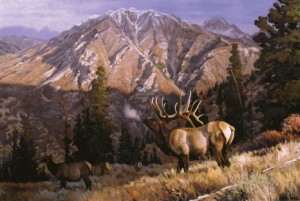 grees with Kauffman that shrubs are not responding to elk behavioral changes. His research shows that after wolves were wiped out in Yellowstone, elk grazing hammered the willows, which drove beavers out. Without beaver dams, streams cut into the ground between their banks, leaving the willows on high terraces. Now, he says, reducing herbivory is not enough to help the willows recover unless the beavers and the water tables are restored as well. “The question is, can you quickly restore a system by putting wolves back in? The answer is no in most places.”
grees with Kauffman that shrubs are not responding to elk behavioral changes. His research shows that after wolves were wiped out in Yellowstone, elk grazing hammered the willows, which drove beavers out. Without beaver dams, streams cut into the ground between their banks, leaving the willows on high terraces. Now, he says, reducing herbivory is not enough to help the willows recover unless the beavers and the water tables are restored as well. “The question is, can you quickly restore a system by putting wolves back in? The answer is no in most places.”
“The wolf is neither a saint nor a sinner except to those who want to make it so,” wrote L. David Mech of the U.S. Geological Survey in his 2012 paper, “Is science in danger of sanctifying the wolf?” He suggests that even scientists have become so attached to the iconic cachet of the wolf story that they credit the species with ecological roles beyond what research has shown for them.
“It’s often misunderstood that if you don’t support the top-down approach you are not an advocate,” said Roy Renkin, a botanist who has studied ungulate herbivory in Yellowstone National Park for 35 years. He agrees that restoring top predators is crucial to ecosystem recovery, but he emphasizes that it’s not clear how to untangle wolf reintroduction influences on vegetation recruitment from other causes.
“The trick is trying to understand the feedbacks of the system,” he said. His research has examined how factors such as shifting winter snowpack, increasing aridity in Yellowstone, and a dramatically lengthened growing season since the time of wolf reintroduction can all influence elk behavior and shrub recovery. He cautions against any ideas that simplify the system, including strong adherence to either a top-down or bottom-up interpretation of ecosystem structure.
“It’s fascinating. And that’s science,” he said. “Hypotheses emerge. People question them. That just advances science.”
Kauffman’s findings have not seen the popularity of the earlier BMTC findings. “There are lots of people who are pro wolves and pro restoring predators who saw my paper as ‘hurting the cause,’” said Kauffman. Even though he doesn’t believe the BMTC is happening the way it was first proposed in Yellowstone, he supports wolf recovery as necessary to restore wildness to the Park. “I think hands down wolf recovery is one of the most remarkable achievements and success stories in the history of wildlife management. …We have plenty of reasons to reintroduce wolves. We don’t need this ecological one.”
Emilene Ostlind has reported on natural resource issues in the West for five years and is editor of Western Confluence.
Dave Wade grew up hunting and studying wildlife in the Rocky Mountain West. Dave has been painting full time since 1976. He attended the University of Utah in Salt Lake City and the Art Center College of Design in LA.
Endnotes
Creel, S. & Christianson, D. (2010) Wolf presences and increased willow consumption by Yellowstone elk: implications for trophic cascades. Ecology, 90, 2454-2466.
Kauffman, M. J., Brodie, J. F., & Jules, E. S. (2010) Are wolves saving Yellowstone’s aspen? A landscape-level test of a behaviorally mediated trophic cascade. Ecology, 91, 2742-2755.
Mech, L. D. (2012) Is science in danger of sanctifying the wolf? Biological Conservation, 150, 143-149.
Ripple, W. J., & Larsen, E. J. (2000) Historic aspen recruitment, elk, and wolves in northern Yellowstone National Park, USA. Biological Conservation, 95, 361-370.
Ripple, W. J., Larsen, E. J., Renkin, R. A., & Smith, D. W. (2001) Trophic cascades among wolves, elk and aspen on Yellowstone National Park’s northern range. Biological Conservation, 102, 227-234.
Ripple, W. J., & Beschta, R. L. (2007) Restoring Yellowstone’s aspen with wolves. Biological Conservation, 138, 514-519.
Schmitz, O. J., Beckerman, A. P., & O’Brien, K. M. (1997) Behaviorally mediated trophic cascades: Effects of predation risk on food web interactions. Ecology, 78, 1388-1399.
Schmitz, O. J. (2008) Effects of predator hunting mode on grassland ecosystem function. Science, 319, 952-954.

